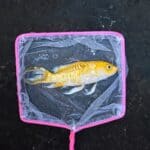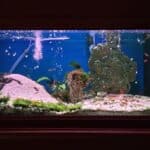Last Updated on: 5th November 2023, 05:26 pm
A power cut will happen occasionally, leaving you without electricity. Fish are usually OK after a few hours with no power, but if it continues longer than 3 hours, their lives are in danger.
If the tank is understocked, the fish could survive for a few days. If it’s too full, they’ll likely start to die after a few hours. The issues are the amount of dissolved oxygen in the water and its temperature.
The oxygen can run out quickly, while sudden drops or rises in temperature can stress the fish, killing them. Similarly, ammonia is likely to rise when there’s no filtration system to pump out the toxins.
Will My Fish Die If The Power Goes Out?
Power outages can last anywhere from a few seconds to a few days.
If the power goes out briefly, it’s unlikely the fish will be too affected. On the other hand, if the power outage lasts for several hours or days, the fish’s survival depends on how stocked the tank is.
For example, fish in a well-stocked aquarium can survive between 3-12 hours without power.
Fish in an understocked tank will fare better, surviving for up to a day or two. If the tank’s overstocked, fish will die 3-9 hours after the power goes out.
Any power outage longer than three hours is a problem. Most modern tanks require electricity to run the pumps, filters, lights, and heaters.
Power loss will affect conditions in the tank, upsetting the fish and putting their lives in danger.
How quickly fish die depends on the following factors:
Oxygen Depletion
During a power outage, your fish will continue to consume the oxygen in the tank. As described by the U.S. Geological Survey, fish need oxygen to survive.
They get it from the water’s dissolved oxygen, which is created by an aeration device that agitates the water. Without a working machine, the oxygen supply becomes limited, slowly suffocating the fish.
As the fish begin to use up the oxygen that’s left, oxygen depletion occurs.
This is a dangerous situation for your fish to be in. Most fish need around 8 PPM of dissolved oxygen in the tank to survive, which they can’t get when there’s a loss of power.
Fish deprived of oxygen will:
- Gasp for air at the water’s surface.
- Move less.
- Lose their appetite.
- Rapidly open and close their gills.
When this happens, you must create the oxygen your fish needs to survive.

Water Temperature
Most aquarium fish need the water’s temperature between 72 to 82 degrees to survive.
Cold water can kill warm-water fish, especially when the temperature drops due to a power outage. Similarly, if the water becomes too warm, the water loses its dissolved oxygen because it’s unable to hold onto it very well.
While a swing of 3 to 4 degrees in either direction shouldn’t be enough to harm your fish, any more can be fatal. Fish are easily stressed because of environmental changes, so you must step in to regulate the temperature if it rises or drops too much.
Ammonia Buildup
A power outage is likely to cause the filtration system to stop temporarily.
As a result, ammonia levels could rise and reach toxic levels. Ammonia is a toxic nitrogenous waste that’s present in almost all aquariums. When the levels get too high, ammonia can poison and kill fish.
Ammonia is a silent killer. Most owners observe signs of poisoning within 2-3 days, but a power outage is likely to speed this process up. Similarly, the fish will likely be affected without you even realizing it.
Signs of ammonia poisoning include:
- A foul odor coming from the tank
- Fish gasping at the surface
- Lethargy
- Lack of appetite
- Red or cloudy eyes
- Redness or mucus around the gills
When you have a power outage, keep testing the water to ensure the ammonia levels aren’t too high.
They’re unlikely to rise too much if the outage lasts only a few hours, but any longer may kill your entire aquarium before you can stop the ammonia from rising.
Changing pH Levels
Not only must you watch for rising ammonia, but the tank’s pH levels are also likely to change during a power outage. Your fish breathe out carbon dioxide (CO2), but nothing can separate it from the tank. As the amount of CO2 increases, the pH will decrease.
Most tropical fish live in waters with a pH ranging from 6 to 8. Fish don’t adapt well to water outside their natural pH range, as the body can’t cope. As described by Sciencing, fish thrive when the water is the same as their natural environment.
pH levels that are too high are also a problem for the same reason. High pH levels mean that the water is alkaline, while low levels mean they’re acidic.
When the water’s too extreme, it can chemically burn the fish’s skin.
Stress
Stress is one of the biggest killers of fish.
According to the ILAR Journal, even the most minor changes to their environment can cause them to become agitated. Stressed fish will:
- Hide.
- Swim up and down the glass.
- Change appearance.
- Develop a weak immune system.
- Lose their appetite.
- Pick up bacterial infections more easily.
- Become aggressive with each other.
You may overlook your fish’s stress immediately, but the longer you have no electricity, the worse the fish will feel. In this instance, you must act fast to create more pleasing water conditions – at least until the power returns.
Do Fish Tanks Use A Lot Of Power?
The amount of power your fish tank uses depends on the electrical equipment it has and how long it’s on for. The size of your aquarium has little to do with how much electricity it uses.
In a standard tropical tank, the most energy use comes from the following:
- Heater.
- Light.
- Filter.
- Water pump.
A small 10-gallon tropical tank that runs at a temperature of 72 F uses around 150 kWh a year.
A medium-sized 30-gallon tank runs between 150-200 kWh, while a 55-gallon tank needs between 200-400 kWh to run each year.
Your tank’s lighting system will likely use the most electricity, accounting for approximately 45% of the total energy expenditure.
The heater uses around 35%, while filters run on about 12% of your tank’s overall power.
If you have an air pump or similar device, this will use the remaining 8% of the power. Other devices used include the following:
- Water pumps: 3-400 Watts, depending on the gallon per hour.
- Powerheads, air pumps, and filters: 3-50 Watts.
- UV filter: 8-130 Watts.
Because these electrical devices are essential to keeping your fish alive, an extended power outage is a serious problem. Planning for an event like this is the best way to keep your fish safe.
How To Give Fish Oxygen Without Power
Once you’ve realized you have no power, one of the most important things you need to do is oxygenate the tank. Otherwise, it won’t take long for your fish to suffocate, particularly if you have many fish.
The good news is you can oxygenate the tank without electricity. However, most methods will require a little elbow grease. As a result, you can create oxygen in the following ways:
Manual Oxygenation
If you don’t have access to a battery-powered oxygenation device, you can manually oxygenate the tank with a cup, pitcher, scoop, or anything holding water. To do so:
- Place a heavy dish onto the substrate to prevent the process from disturbing it.
- Find a clean cup, jug, or something similar, and scoop out as much water in one go as you can.
- Hold the cup above the tank and pour the water back in.
- Repeat this process multiple times.
As you do this, the water picks up air and drives oxygen into the tank. The higher the distance you pour the water from, the more oxygen goes into the tank. That’s because the water’s more likely to hit the bottom, which aerates and oxygenates the entire tank.
Similarly, you’ll add more oxygen to the water the more you repeat this process. This process is hard work, so split it throughout the day into hourly intervals, monitoring your fish for any signs of suffocation. If they begin to gasp for air, repeat the process several times. Repeat this as often as you need to.
Battery-Powered Air Pump
One of the most valuable tools you could own during a power outage is a battery-powered air pump. While they don’t pump much air into your tank, it’s enough to keep the oxygen levels stable until the power returns.
The best pumps are the ones that predominantly use electricity but switch to the internal rechargeable battery whenever the power goes out. This means the pump will keep working, meaning you don’t have to do anything.
However, pumps powered by D-cell batteries are also effective if you monitor the battery levels. Keep a spare pack in a drawer just in case you suffer from a lengthy power outage, and your original batteries run out of juice.
How To Heat A Fish Tank Without Power
When you lose power, the tank’s water temperature will likely drop to room temperature, which is around 68 to 72 degrees Fahrenheit. For many fish, this is too cold.
Most fish do relatively well with a gradual fall in temperature over 24 hours, though they may become sluggish. Once the power goes back on, they should fully recover.
However, if the water cools too rapidly, the fish risk getting sick or stressed. The rate at which the water temperature drops depends on the:
- Air temperature of the room where you house your fish tank.
- Size of the tank.
- The volume of water – a larger volume takes longer to cool.
To keep your tank warm while you have no electricity, follow these steps:
Insulate The Tank
To help insulate the heat your tank already has, cover it with a blanket or sheet. Similarly, keep the lid closed and place sheets of Styrofoam over the tank if you have them.
The critical thing to remember here is that you’re not trying to raise the temperature – you’re trying to maintain it so it doesn’t drop too low.
Smaller tanks lose heat quicker than larger tanks, so you’ll need to move fast if your tank’s only little. Similarly, if you have a gas or wood-burning fireplace in the same room as your fish, put it on to heat the room and, subsequently, the water.
One of the best things about using a tank covering is that it blocks out ambient light, forcing your fish into believing it’s night-time. As a result, they’re more likely to sleep and will stop moving, reducing the amount of dissolved oxygen they consume.
Calcium Chloride
This is a method you’ll have to forward plan for, as not many households have calcium chloride, which is a type of salt, lying around.
You can heat a fish tank using a solution of calcium chloride and water. To make it:
- Fill 70 to 80% of a 500 ml plastic bottle with tank water.
- Add 100 g of calcium carbonate and shake it. A chemical reaction will take place, causing the bottle to radiate heat.
- Place the bottle in the tank. Depending on how much air is in the bottle, it’ll either sink or float.
This bottle will give off enough heat to regulate the temperature. However, it will eventually drop to match the temperature of the water.
You should have between 70 to 90 minutes before replacing it.
Heat Packs
Heat packs are regularly used in the fish-keeping industry to keep fish alive while transporting them. You can find them in hardware stores, making them easy to buy, even during a power cut.
To keep your tank’s water temperature regulated, snap or shake them and place them on the outside and the bottom of the tank. Never put them in the water unless tightly sealed in a zip-lock bag.
The average heat pack warms up to 130 degrees Fahrenheit, so they should help keep the water warm for a little while. Heat packs are also best for small aquariums.
For best results, cover them to transfer the heat straight back into the tank.
How To Cool A Fish Tank Without Power
If you experience a power outage in the middle of the summer and the room temperature is very warm, the water’s at risk of getting too hot. Fish better suited to cold water, such as goldfish, will suffer.
You can cool a fish tank down by:
- Removing the lid. However, if you do this, keep monitoring the tank to save any fish that may attempt to jump out to escape the conditions.
- Manually fan the top of the water’s surface to cool the water.
- Close all blinds and curtains within the room to block any sunlight.
- Slowly place ice cubes into the tank, careful not to lower the temperature too quickly.
Aim to keep the water as close to 78 degrees as possible or whatever works best for your fish.

How To Keep Fish Alive When The Power Goes Out
Unfortunately, keeping your fish alive during a power outage takes more than improving the oxygen levels and maintaining the correct temperature.
There are several other complications you must factor in to save your fish.
As a result, in the case of a power loss, do these things:
Be Prepared Beforehand
While power outages aren’t that common, they happen, especially in climates prone to storms and other extreme weather. You can never be too prepared, so purchase some essential power outage equipment before it happens. You’ll need:
- An automatic or portable generator.
- A backup power supply.
- Test equipment.
- Thermometer.
- A battery-powered air pump or wave-maker.
- Water containers.
- Hand warmers.
- Blankets.
- Plenty of batteries.
We’ve explained how some of these pieces of equipment have an essential part to keep your fish alive, but depending on how long the outage lasts, you’ll need all of these things to save your fish.
In particular, an automatic generator and backup power supply keep the tank running as usual, even if there’s no electricity.
Unplug The Filter
One of the first things you should do when you lose electricity is to unplug all your equipment, including the filter. Even though this doesn’t seem logical, it makes sense because the water in the filter has nowhere to go.
As a result, the toxins and waste that would get flushed out become harmful, creating unsanitary conditions for your fish. Not only can this make them physically unwell, but it will cause additional stress.
Similarly, rinse the filter. If the filter media is more than a week old, replace it and rinse the filter thoroughly. However, if you use a biological filtration component, submerge it in water to preserve the beneficial bacteria.
If you don’t, the tank will go through the entire cycling process again, causing dangerous conditions that will put your fish in further danger.
Avoid Feeding The Fish
While the filter’s not working, avoid feeding your fish.
Most tropical fish can survive for a few days without eating. That’s because, in the wild, they only eat when they can find food, which doesn’t come as readily as in a tank. As a result, they’re used to fasting.
Feeding during a power outage increases the fish’s activity levels, reducing the amount of oxygen.
It’ll also cause them to poop more often, which makes ammonia and nitrites rise more quickly. These conditions harm your fish, especially when there’s no working filtration system to remove the toxins.
If you have a power outage, try not to panic. As long as it only lasts for a few hours, the fish should be OK.
While it’s always best to be prepared with the right equipment, you can save your fish with some work and constant supervision.







